Photovoltaic solar cells generate electricity as a result of light photons hitting their surface. PV cells generate direct current (DC) which then is converted into alternating current (AC) by an inverter to be consumed by electric appliances. Typically solar cells produce 0.5V voltage so they are strung together as a module to get more power. A module usually encompasses 6 x 10 grid of cells. PV modules then are combined in PV arrays to provide the required amount of power. Modules are rated by the power they produce under the standard test conditions (STC) measured in Watts. The efficiency of a panel is the percentage of generated power versus the total solar power incident on the panel's surface. In other words, a panel with twice lower efficiency than another panel has to have twice the other panel's surface to generate the same amount of power.
Monocrystalline vs Polycrystalline Solar Panels
If you have found yourself wondering which PV panels are right for you then you'll be pleased to know that there is no difference for you as an end user. Let's say you have 2 panels in front of you one of them made from monocrystalline silicon and the other made from polycrystalline silicon. if both of the panels have the same rated power, say 300W under standard test conditions (STC), and they don't have negative power tolerance then the manufacturers have already accounted for the specifics of the given silicon type so that both panels will have at least 300W output. That may mean that the monocrystalline panel is negligibly smaller than the polycrystalline one but in practice, there is no noticeable difference in sizes. In terms of longevity, both panels have the same temperature coefficient so they last the same number of years. This is why silicon type (mono vs poly) is not a decisive factor when choosing a panel. The important factors are the rated power and the efficiency of the panel.
Panasonic
Characteristics
- Uses ultra-thin amorphous silicon layers
- Module Efficiency: 19.1%
- Temperature coefficient: -0.258% / °C
- Low Light-Induced Degradation (LID)
Panasonic has been in solar panel business since 1975. From 1997 a line of panels called HIT hit the market. There are currently 8 variations of panel models. Initially, there were 4 panels in this series: N325 HIT (VBHN325SA16), N325 HIT 40mm (VBHN325SA17), N330 HIT (VBHN330SA16), N330 HIT 40mm (VBHN330SA17). Later 4 new models featuring an all-black design were introduced. They have the BLACK label in their title. Here are those panels: N315K HIT BLACK (VBHN315KA01), N320K HIT BLACK (VBHN320KA01), N320K HIT BLACK 40mm (VBHN320KA03), N325K HIT BLACK 40mm (VBHN325KA03).
Panasonic HIT
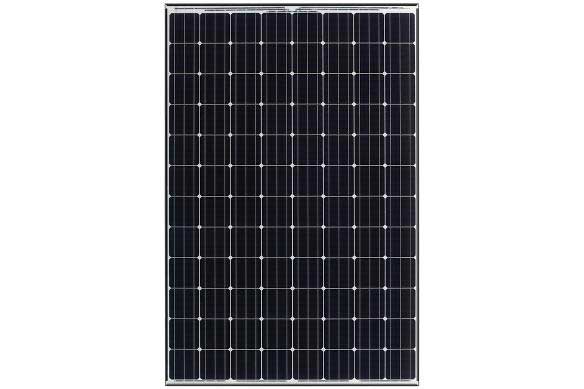
HIT series panels have 96 cells. 40mm marking in the title refers to new Enhanced frame design. The defining characteristic of these panels are
- Pyramid cell structure design. This design lets the panel absorb more sunlight by directing more rays inside the panel instead of reflecting them. The special treatment of the surface of the panel creates tiny pyramids on it for this purpose.
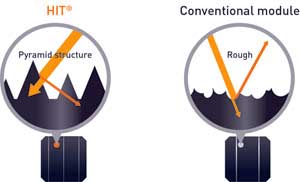
- HIT series panels also feature Heterojunction technology. What it does is combine amorphous and crystalline silicon layers so as to reduce the recombination rate of the electrons. Lower electron recombination rate means higher power output.
- Another improvement is the rainwater drainage frame design. Confining rainwater to flow through the frame prevents water stains and dirt built-up on the surface further enhancing light absorption.
- Panasonic HIT series has a rather low temperature coefficient of -0.258%/°C. That means that every 1°C increase in temperature above 25 °C results in 0.258% power loss. That's quite a good coefficient.
- All the panels, including BLACK series, that don't have "40 mm" in their title are bifacial meaning they can capture the sunlight both from the front and rear sides. Rear side absorbs the rays reflected from the roof surface. In combination with the "Pyramid cell structure" technology bifacial design increases the power generation due to the increased influx of irradiation.
Electrical Specifications
| N325 HIT* | N330 HIT* | |
|---|---|---|
| Model | VBHN325SA16 | VBHN330SA16 |
| Rated Power | 325W | 330W |
| Voc | 69.6V | 69.7V |
| Temperature Coefficient | -0.258%/°C | -0.258%/°C |
| Module Efficiency | 19.4% | 19.7% |
| Watts per Ft.² | 18W | 18.3W |
| Warranted Tolerance | -0% / +10% | -0% / +10% |
| Number of cells | 96 | |
| Module Area | 18.02 Ft.² (1.67m²) | |
| Weight | 40.81 Lbs. (18.5kg) | |
| Dimensions LxWxH | 62.6x41.5x1.4 in. (1590x1053x35 mm) | |
| Warranty | 25 years (product and performance) | |
*The specifications for the N325 HIT 40mm and N330 HIT 40mm are omitted because they both have the same characteristics as their counterparts except that the panel's height is 40mm instead of 35mm. Another difference is that N325 HIT 40mm has 3.34mA/°C temperature coefficient compared to N325 HIT's 3.32mA/°C.
Panasonic HIT BLACK
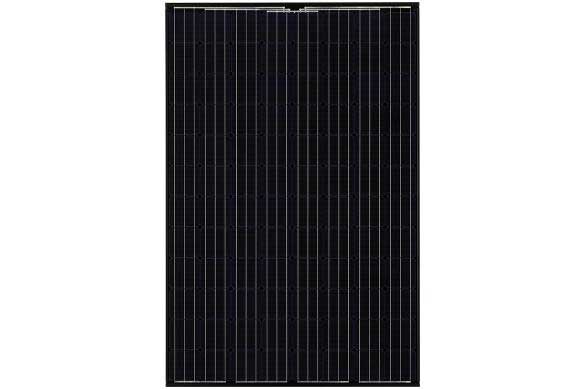
The HIT BLACK series is a later addition to the HIT series. The panels of this series have an all-black sleek appearance and higher efficiency than its predecessors. HIT BLACK series has all of the advantages of HIT series, in particular, BLACK panels also feature Pyramid cell structure design, Heterojunction technology, rainwater drainage, and low temperature coefficient.
Electrical Specifications
| 315K Black | 320K BLACK | 325K BLACK, 40mm | |
|---|---|---|---|
| Model | VBHN315KA01 | VBHN320KA01 | VBHN325KA03 |
| Rated Power | 315W | 320W | 325W |
| Voc | 70.2V | 70.5V | 70.9V |
| Temperature Coefficient | -0.258%/°C | -0.258%/°C | -0.258%/°C |
| Module Efficiency | 18.8% | 19.1% | 19.4% |
| Watts per Ft.² | 17.5W | 17.8W | 18.03W |
| Warranted Tolerance | -0% / +10% | -0% / +10% | -0% / +10% |
| Number of cells | 96 | ||
| Module Area | 18.02 Ft.² (1.67m²) | ||
| Weight | 40.81 Lbs. (18.5kg) | ||
| Dimensions LxWxH | 62.6x41.5x1.4 in. (1590x1053x35 mm) |
H = 1.57" (40mm) | |
| Warranty | 25 years (product and performance) | ||
LG Solar Panels
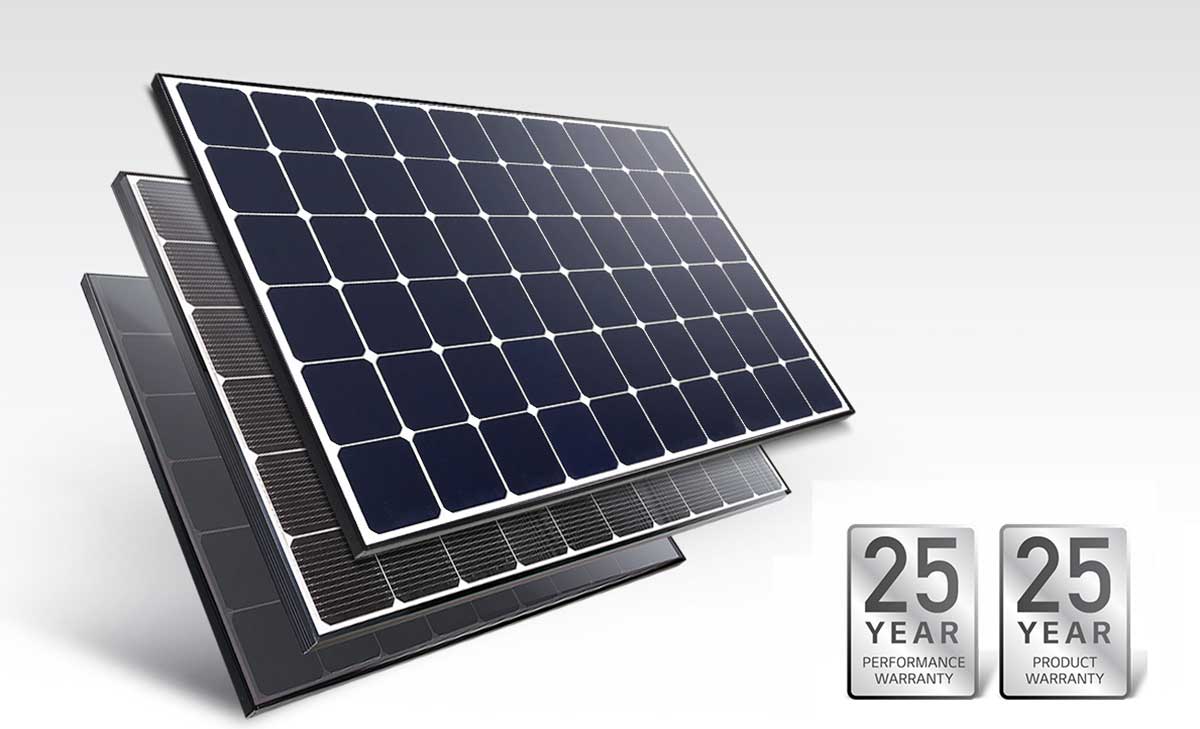
LG has 2 series of solar panels called NeON and MonoX. NeON R is LG's premium panel with the highest efficiency.
NeON R
This is a black panel without metal electrodes on the front side.
| LG350Q1C | LG360Q1C | LG365Q1C | LG370Q1C | |
|---|---|---|---|---|
| Rated Power | 350W | 360W | 365W | 370W |
| Efficiency | 20.3% | 20.8% | 21.2% | 21.4 |
| Temperature Coefficient | -0.3%/°C | -0.3%/°C | -0.3%/°C | |
| Performance after 25 years | 88.4% | |||
| Dimensions | 67" x 40" x 1.6" (1700 x 1016 x 40 mm) | |||
| Weight | 40.8 lbs (18.5kg) | |||
| Warranty | 25 years | |||
NeON 2 Line
NeON 2 best selling series of solar modules has 3 sub-types: NeON 2, NeON 2 BLACK and NeON 2 BIFACIAL. The series features LG's Cello Technology. What does Cello Technology do? Instead of 3 ribbons on a solar cell as in NeON 2nd generation, NeON cells have 12 circular wires which facilitate better light absorption by scattering it over the panel's surface more effectively. Moreover, Cello Technology spreads the electrical current within 12 wires thus reducing electrical losses. Streaming the electrical current through 12 wires means mitigation of cell performance degradation thanks to more paths for the current to flow through when micro-cracks naturally occur. Thanks to NeON 2 panel's more rigid frame design it has higher endurance hence the 2 additional years of warranty.
NeON 2
| Number of Cells | 60 Cell | 72 Cell | |||
|---|---|---|---|---|---|
| Rated Power | 330W | 335W | 340W | 395W | 400W |
| Module Efficiency | 19.3% | 19.6% | 19.8% | 19.1% | 19.3% |
| Dimensions |
66.4" x 40" x 1.6" |
79.7" x 40.3" x 1.6" |
|||
| Weight | 39.7 lbs (18 kg) | 47.8 lbs (21.7 kg) | |||
| Performance after 25 years | 86% | ||||
| Warranty | 25 years | ||||
NeON 2 BLACK
NeON 2 Black has aesthetically pleasing design - matte black frame, back sheet and cells. Thin surface wires blend with background which gives the panel sleek, all-black appearance.
| Number of Cells | 60 Cell (6 x 10) |
|---|---|
| Rated Power | 320W |
| Module Efficiency | 18.7% |
| Dimensions | 66.4" x 40" x 1.6" (1686 x 1016 x 40 mm) |
| Weight | 39.7 lbs (18 kg) |
| Performance after 25 years | 86% |
| Warranty | 25 years |
NeON 2 BIFACIAL
NeON 2 BIFACIAL can absorb sunlight both from the front and rear sides. The rear is covered with a transparent sheet to collect the reflected light and diffuse solar radiation. This obviously leads to higher energy generation. Depending on the reflectiveness of the surface BiFacial panel is mounted on, the additional generated energy can reach up to 30%. The most favorable surface in this respect is the white, plain surface.
| Number of Cells | 72 Cell (6 x 12) | |
|---|---|---|
| Rated Power | 390W | 395W |
| Module Efficiency | 18.5% | 18.7% |
| Dimensions | 81.3" x 40.3" x 1.6" (2064 x 1024 x 40 mm) |
|
| Weight | 48.7 lbs (22.1 kg) | |
| Performance after 25 years | 86% | |
| Warranty | 25 years | |
LG MonoX Plus
MonoX Plus is a very robust panel using LG's LiLY technology to ensure high performance. LiLY stands for LID improvement for Lifetime Yield and is aimed at decreasing Light-Induced Degradation (LID). The widely known cause of LID is Boron - Oxygen combination in a silicon crystal. LiLY hinders LID by forming a Boron - Hydrogen pair during the manufacturing process. MonoX panels have high durability handling the rated pressure of 6 kPa on front and 5.4 kPa on the backsides.
| Number of Cells | 60 Cell | 72 Cell | ||||
|---|---|---|---|---|---|---|
| Rated Power | 290W | 295W | 300W | 350W | 355W | 360W |
| Module Efficiency | 16.9% | 17.2% | 17.5% | 16.9% | 17.1% | 17.4W |
| Dimensions | 66.4" x 40" x 1.6" (1686 x 1016 x 40 mm) |
79.7" x 40.3" x 1.6" (2024 x 1024 x 40 mm) |
||||
| Weight | 39.7 lbs (18 kg) | 47.8 lbs (21.7 kg) | ||||
| Performance after 25 years | 86% | |||||
| Warranty | 25 years | |||||
SolarWorld SunModule Solar Panels
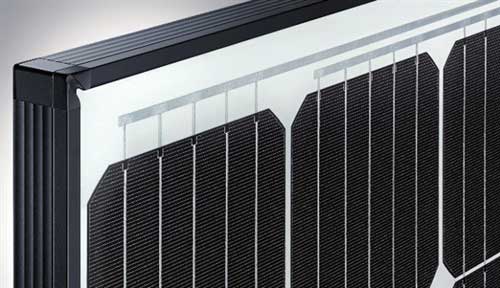
SolarWorld is a German solar company. The company supports all levels of solar technology lifetime starting from module production, marketing and ending with after-sale service. There are several key points that set SolarWorld's SunModule series apart from the competition: specifically spaced cells in a module helps to reduce operating temperature by reflecting excess sunlight. Frame spacing is intended to reduce shading caused by hardware and dust by leaving enough space between the frame and the cells. An extra durable frame is designed to withstand heavy snow piles and it is scratch-resistant. Patented "Corner key" technology streamlines self-cleaning by integrated drainage design. SolarWorld's Plus-Sorting means that the panels' rated power is equal or surpasses the rated power on the nameplate. SolarWorld panels guarantee maximal annual degradation of 0.7% in the course of 25 years. The company's experience is over 30 years encompassing all the stages of the solar value chain starting from raw silicon to panels, kits, and solar farms.
Models SWA 290, SWA 295 and SWA 300
| Model | SWA 285 | SWA 290 | SWA 295 | SWA 300 |
|---|---|---|---|---|
| Rated Power | 285W | 295W | 295W | 300W |
| Voc | 39.2V | 39.6V | 39.8V | 40V |
| Efficiency | 17% | 17.3% | 17.59% | 17.89% |
| Number of cells | 60 cells | |||
| Temperature Coefficient | -0.39%/°C | |||
| Dimensions | 65.95" x 39.4" x 1.3" (1675 x 1001 x 33 mm) | |||
| Weight | 39.7 lbs (18kg) | |||
| Linear Performance Guarantee | 25 years | |||
Renogy Solar Panels
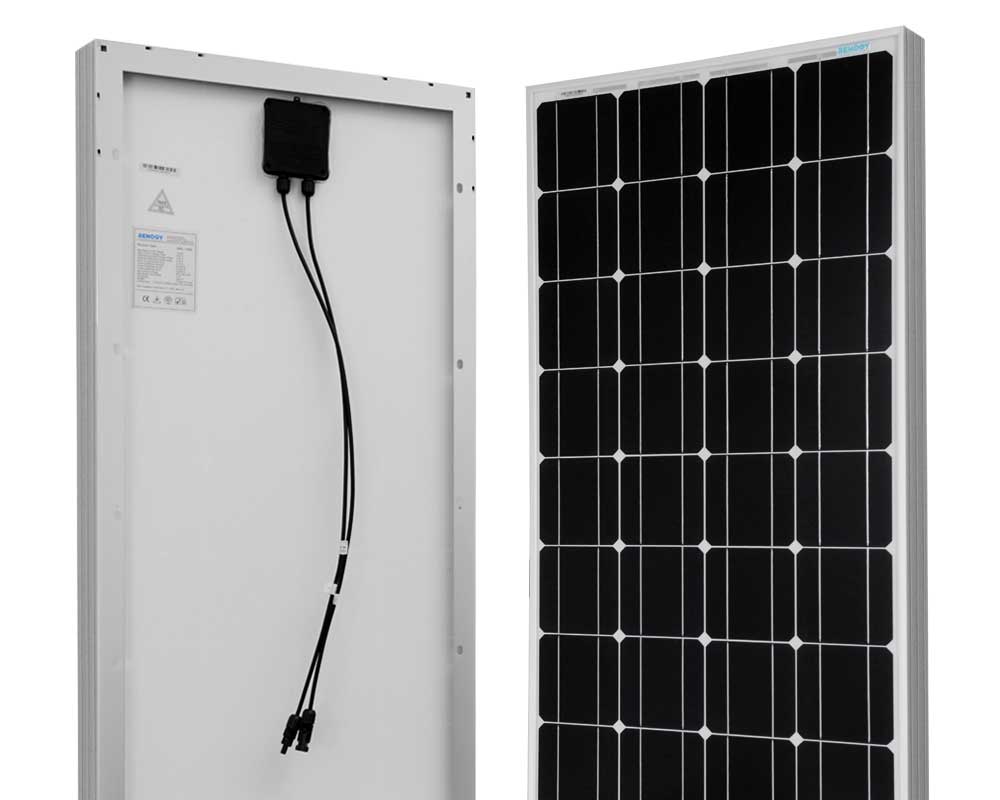
Renogy has started small by a group of students in Louisiana State University. The startup has grown into a mature company now offering a range of solar products from solar panels and charge controllers to accessories and wiring. The company's solar panel selection is wide. They offer rigid, flexible/lightweight and panels in a portable suitcase. The rigid panels have rated power starting from 30W and reaching to 300W, both monocrystalline and polycrystalline versions are available. These panels are covered with a protective layer of tempered glass; the frame is made of aluminum. These panels can be used in kind of applications with flat roofs like for homes, sheds, cabins and so on. Renogy solar panels are electroluminescence (EL) tested. EL testing can reveal in real-time cell breakage, surface cracks and fissures of a few of a millimeter. EL testing prevents flawed panels from getting into the market.
Key Features:
- Electroluminescence (EL) tested solar modules
- Bypass diodes minimize the effects of a shade and enhance the performance in low-light conditions
- Pre-drilled holes on the back allow for faster mounting & securing
- Compatible with Renogy mounting hardware like Z-Brackets & Tilt Mounts
- No hot spots guaranteed
| Model | RNG-10D | RNG-20D | RNG-30D |
|---|---|---|---|
| Rated Power | 10W | 20W | 30W |
| Voc | 21.6 V | 21.6 V | 21.6 V |
| Vmp | 17.5 V | 17.5 V | 17.5 V |
| Isc | 0.62 A | 1.23 A | 1.85 A |
| Imp | 0.57 A | 1.14 A | 1.71 A |
| Efficiency | 13.03% | 12.33% | 14.37% |
| Temperature Coefficient of Pmax | -0.23%/ºC | -0.23%/ºC | -0.23%/ºC |
| Number of Cells | 36 (12 x 3) | 36 (2 x 18) | 36 (2 x 18) |
| Solar Cell Type | Monocrystalline | Monocrystalline | Monocrystalline |
| Dimensions | 7.3" x 16.3" x 1" (185 x 415 x 25 mm) | 13.5" x 18.5" x 1" (345 x 470 x 25 mm) | 13.5" x 23.8" x 1" (345 x 605 x 25 mm) |
| Weight | 3.5 lbs (1.58 kg) | 4.8 lbs (2.2 kg) | 6.2 lbs (2.8 kg) |
| Model | RNG-50D | RNG-100D | RNG-300D |
|---|---|---|---|
| Rated Power | 50W | 20W | 300W |
| Voc | 22.7 V | 22.5 V | 39.82 V |
| Vmp | 18.5 V | 18.9 V | 32.25 V |
| Isc | 2.84 A | 5.75 A | 9.78 A |
| Imp | 2.7 A | 5.29 A | 9.33 A |
| Efficiency | 14.67% | 15.47% | 18.24% |
| Temperature Coefficient of Pmax | -0.23%/ºC | -0.44%/ºC | -0.47%/ºC |
| Number of Cells | 36 (4 x 9) | 36 (4 x 9) | 60 (6 x 10) |
| Solar Cell Type | Monocrystalline | ||
| Dimensions | 24.8" x 21.3" x 1.2" (630 x 541 x 30 mm) | 47.3" x 21.3" x 1.4" (1202 x 541 x 35mm) | 13.5" x 23.8" x 1" (345 x 605 x 25 mm) |
| Weight | 9.9 lbs (4.5 kg) | 16.5 lbs (7.5 kg) | 6.2 lbs (2.8 kg) |
| Power Output Warranty | 25 years | ||
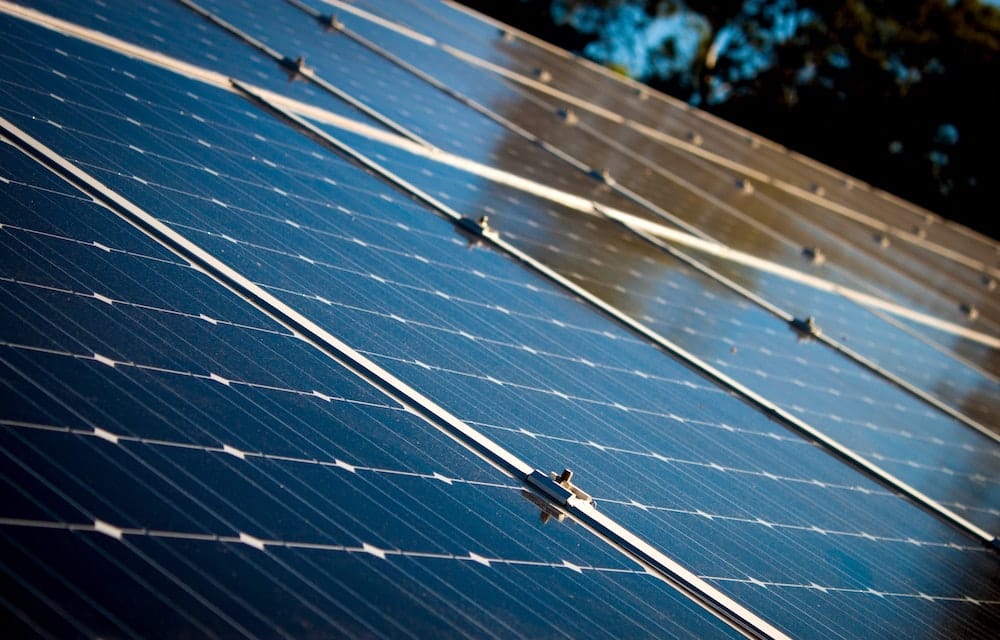




Comments